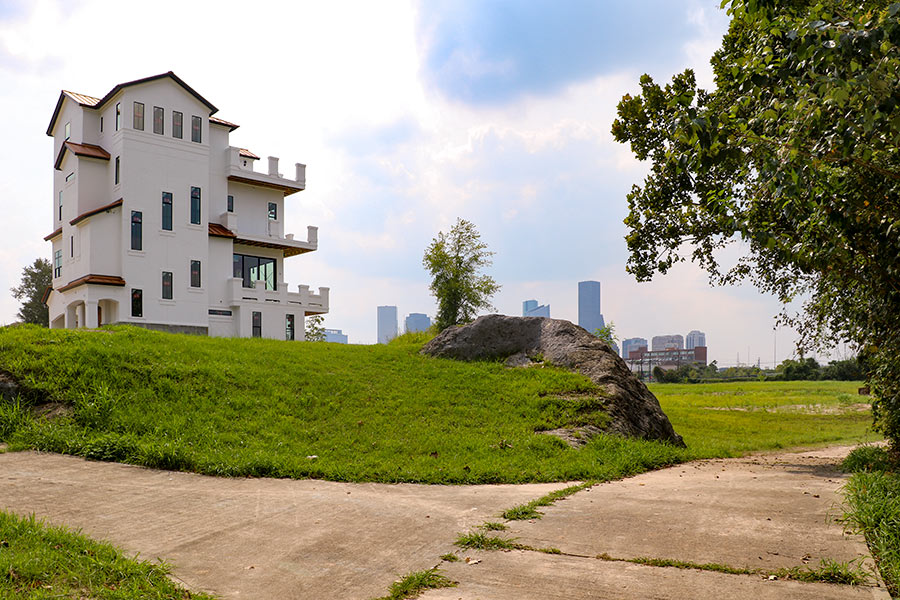OUR PLACE NEVER FLOODED  Cort MacMurray gazes into the city’s future: “. . . Houston is a cheerful amnesiac: We will rebuild in exactly the same places we built before, with exactly the same disrespect for historic floodplains. We are united, but in making this place stronger we’ll ignore fundamental inequities like school finance. We have a stronger work ethic than any other city in the Union, but when this crisis is past, we’ll slide back into affable indolence, trusting that everything is fine in our sprawling Xanadu on the Bayou.” [Houston Chronicle] Photo: Christof Spieler, via Swamplot Flickr pool
Cort MacMurray gazes into the city’s future: “. . . Houston is a cheerful amnesiac: We will rebuild in exactly the same places we built before, with exactly the same disrespect for historic floodplains. We are united, but in making this place stronger we’ll ignore fundamental inequities like school finance. We have a stronger work ethic than any other city in the Union, but when this crisis is past, we’ll slide back into affable indolence, trusting that everything is fine in our sprawling Xanadu on the Bayou.” [Houston Chronicle] Photo: Christof Spieler, via Swamplot Flickr pool





I think that there is a massive gap between global public perceptions about flood control and subsidence efforts (which are basically the same thing) and what is actually going on in the arcane and perfectly tangible but oft-overlooked intersection of civil engineering and mostly state and municipal finance.
.
Where money has been spent, and we’re talking about multiple simultaneous projects often in the hundreds of millions of dollars each, there has been real and observable progress. In particular, consider improvements to the White Oak, Brays, and Sims Bayou watersheds, the hardening of the Texas Medical Center and other institutions, and the massive project to take the northern suburbs off of well water and put them on surface water from Lake Houston, which now includes water pumped from the Trinity River. At a smaller scale but no less important, individual subdivisions now include far more stringent requirements for stormwater detention and conveyance. These requirements are why the western portions of The Woodlands are so strikingly different from the eastern portions; the amount of re-grading of land that is requirement precludes the preservation of most trees. But it is effective, and much of the terrifying iconographic imagery of TS Harvey, of single-family homes surrounded by a halo of green and then murky brown beyond it…that is the proof that’s in the pudding. (Not that it wasn’t discomforting to those who watched it creep up to the foundation before receding.)
.
None of these projects by themselves is any sort of panacea; and some of the damage that was done to the region’s landscape in the mid-20th century is irreversible. It is totally unreasonable that every possible chance of flooding should be eliminated throughout it. At some point the cost of protection from rain, from wind, or from storm surge is greater than the benefit. We have to recognize that and the enormity of the challenge. But we can’t simply resign ourselves to some notion about Houston’s flood control efforts as having been ill-considered or impotent. They aren’t. They *are* underfunded. That is a banal legislative task which gen pop need not worry itself about. Houston’s business leaders, the real estate community, and the insurance lobby surely have that in hand for a couple of election cycles. If there is any sort of failing which is consistent with Christof Spieler’s prognostications, that is where it lay; the damned corporatists haven’t rent-seeked as thoroughly as might’ve reasonably been expected.
What’s with the unneeded and arguable comment about government school finances? The inequities, if they exist, is that those benefiting are not paying their fair share. No where else in public finance is this chasm so wide as in school financing.
Two of the traditionally poorest neighborhoods in Houston didnt even have street flooding in 2nd Ward (Picture Above) and 5th Ward. Combining the bayou bottleneck of downtown, the widening of the bayou on the east end, and the high elevation it may become prime property for those looking to escape the risk of future flooding in the downtown loop.
EADO didn’t flood whatsoever. Come to EADO!
Minor point – Christof Spieler took the photo on the post. The Chronicle piece was written by Cort McMurray.
@Mr. Clean – It’s likely to happen, I think. I suspect you’ll start seeing “Didn’t flood in Harvey” as a selling point in future real estate listings, which will drive up the land values, and drive the poor out to the flooded areas (which is par for the course). It’s no wonder that happened, though. Many of the oldest neighborhoods in Houston are also predominately minority. And the oldest neighborhoods (read, first settled) are the highest points in Houston. After all, who is going to settle in a lowland when the “highlands” are still available?
@TheNiche – I disagree that “gen pop” doesn’t need to concern themselves about the legislation of flooding. There are much more cost-effective ways to address flooding than building more retention ponds and bigger channels, but they don’t make money for developers or big construction firms. They require activity on the personal level, such as installing rain gardens and permeable surfacing on home lots. But many people don’t know about it, and our “flood czar” is stuck in the 1980’s mindset.
One fix: Offer reduced parking requirements for people willing to use that same space for green space. I had a building I wanted to use as a restaurant but I didn’t want any parking. This property was located where there is tons of housing density (and light rail) so I assumed I didn’t’ need people to drive. Plus I think parking lots are ugly. And I wanted this place to be a place locals walked or biked to.
.
The area that would normally be for cars would have been for green space and outdoor seating.
.
Nope. City wouldn’t let me do it. Even though a shift to that style of commercial property (and overall mindset) would help tremendously in massive flood events like this.